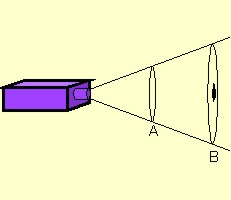Infrasound, EVP and IR thermometers

IR (laser) thermometer
One of the most popular instruments used on vigils is the thermometer. This is probably because it is cheap and easy to obtain. In addition, haunted places often produce thermal anomalies like cold spots.
As with so many other things, electronic versions have largely replaced the traditional mercury thermometer. One particularly popular variation is the infra-red (or laser) thermometer. This clever device measures temperatures remotely. You just point it at an object and it reports its surface temperature.
On the face of it, the infra-red thermometer is a handy gadget for vigils, particularly to ‘reach’ areas that can’t be directly approached. However, as with all instruments, you need to understand how it works to avoid pitfalls.
The infra-red thermometer, like all the instruments used on vigils, was not designed for ghost hunting! It is primarily an industrial tool. It works by measuring the ‘black body’ radiation emitted by a remote object. This wavelength of this radiation is related to the temperature of the object. It does not pick up the temperature of the air between the object and thermometer.

To see how it works, think of the IR thermometer as a camera. It ‘sees’ an area proportional to the distance from the thermometer. So, in the diagram above, the area covered at distance ‘B’ is much larger than at ‘A’. The spot in the middle of the circle at ‘B’ is the laser guide dot used to line it up - it is much smaller than the area actually sampled (and averaged to produce a reading). So, it can be difficult for operators to know how much surface is actually covered when temperatures are sampled (see thermal imagers).
Another problem is that surfaces can produce different readings according to how shiny they are (emissivity). Portable IR thermometers were only accurate to within a degree or two in any case. They CAN be useful but consider their problems and don’t overestimate their accuracy.
EVP
EVP stands for electronic voice phenomena. It is also sometimes called ITC or instrumental transcommunication. However, this is a broader term (also including apparent communication with discarnate entities via TVs, telephones, computers, etc.). EVP tends to refer more narrowly to using sound recording devices to capture voices not heard by witnesses present at the time.
EVP was fairly popular when ASSAP first started (see, for instance, Tony Bowmaker’s article from 1991). In those days, practitioners would build machines, using white noise generators, deliberately designed to detect EVP.
After years of relative obscurity, EVP became popular again, probably because of the film White Noise and other media appearances. In its modern incarnation, people take recording devices to haunted locations in the hope of catching ghostly voices (though there other researchers doing things at non-special locations).
Thus, EVP recording has become a regular feature of vigils. In fact, audio recordings have been made on vigils for a very long time though, until recently, it was to record noises associated with the original haunting reports.
As with any instrument, or other equipment, used on a vigil, you need to understand it properly before deciding you have an anomalous recording. Though audio recorders may now use memory chips instead of tape, the basic technology remains the same with similar problems. There is some advice on the selection and use of audio equipment here. As always, high quality equipment is to be preferred and it should be used in a disciplined, methodical manner if you want recordings of value.
Possible sources of extraneous voices to consider are:
Just as you can photograph orbs anywhere, so you can pick up EVP anywhere, not just in haunted houses. You might want to try EVP at non-haunted locations to compare results.
- real voices, not remembered or simply too faint to be heard by witnesses present at the time of recording
- radio / electromagnetic interference (microphone leads can act as aerials)
- random noises (later interpreted as voices, particularly if altered by audio editing software)
EVP recordings are often fed into sound editing software to amplify them or ‘clean’ them up. Unfortunately, such software can have the effect of introducing artifacts that can be mistaken for voices.
The real problem with EVP comes in demonstrating that the sounds heard are indeed voices. Some EVP samples sound like noise, on first hearing at least, while others are relatively recognisable as voices. Properly analysing recordings is neither simple nor quick but is essential. There is advice on analysing EVP samples here. There is also an EVP sample collection which demonstrates some of the difficulties involved in analysing EVP.
Recording EVP on vigils
The problem with trying to record EVP on vigils is controlling the ‘sound environment’. There will inevitably be noise from people talking, shuffling their instruments and notes, walking about, moving furniture and so on. Very little of this activity tends to get remembered at the time. What is more, sound recorders can be remarkably sensitive, even hearing noise from other rooms. When you play a recording back, it is tempting to regard any apparent voice that you don’t remember as EVP but it could just be something you’ve forgotten.
Even locking off a recorder in an empty room doesn’t necessarily help. With no one there to listen, who knows what perfectly natural sounds the recorder might pick up. Unfortunately, trying to record EVP on vigils isn’t easy!
Infrasound
A few years ago, Vic Tandy suggested that some ghost sightings may be induced by the effect of infrasound on witnesses. It was already known that infrasound could make people feel uneasy and anxious (and so, perhaps, more likely to report paranormal experiences) but Vic suggested that they might experience visual hallucinations as well.
In particular, it was suggested that 19 Hz infrasound might cause a visual disturbance. As a result, paranormal researchers have been looking for infrasound in haunted locations since.
Infrasound is just like audible sound (a compression wave going through the atmosphere) except that the frequency is too low for people to hear it. It is generally defined as below 20 Hz (though such low frequencies CAN be heard if the volume is high enough).
Infrasound has few natural sources but they include ocean waves, avalanches, earthquakes and certain wind conditions (eg. storms, hurricanes and wind shear around mountain ranges).
There are also artificial sources of infrasound. Anything with an engine in it can induce infrasound, particularly any form of transport.
Typically, given the few sources, background infrasound is not very loud. However, if it enters a resonant ‘cavity’ it may be amplified. A resonant cavity, in this case, is a closed volume of space whose dimensions cause the waves to bounce backwards and forwards (or resonate). A room in a building may be of a suitable specific dimensions (which depends on the wavelength of the infrasound) to cause such resonance.
One confounding problem with infrasound is that it operates at the same frequencies as EIFs (experience-inducing fields) that could produce magnetic hallucinations. Thus if there are any suitable metal objects in the area, they may vibrate in sympathy with the infrasound (or they could even be its source eg. an engine). Thus, when infrasound is suspected as the source for a haunting, the possibility of magnetically-induced hallucinations must be eliminated.
Unfortunately, infrasound detectors are not cheap! Many are designed for geophysical use (monitoring volcanoes or earthquakes). Some people have even tried to make their own. This is fine, so long as you know what you’re doing! If it is to be attached to a computer you’ll need to consider all the usual problems with A-D conversion (like aliasing and calibration). Either that or be prepared to spend a lot!